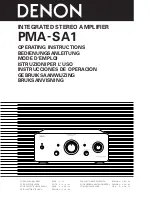
6
ENGLISH
ENGLISH
q
Power switch (POWER)
When the POWER switch is turned ON (
¢
), the Power
indicator
w
lights.
When the Power switch is turned ON, power is supplied to
the unit. It takes a few seconds after the power is turned on
for the unit to warm up. This is due to the built-in muting
circuit that eliminates noise during the on/off operation.
w
Power indicator
This indicates the set’s operating status.
The indicator flashes red for several seconds when the
power is turned on and when the position of the EQ
POWER switch
e
and BALANCED INPUT switch
y
is
changed, indicating that the muting circuit is activated
(interrupting the speaker output). In the normal operating
mode, the indicator is orange when the EQ POWER switch
e
is set to the OFF (
£
) position, green when it is set to
the ON (
¢
) position.
Also, if the protective circuit is activated (due to a short-
circuit in the speaker output, DC output to speakers,
abnormal temperature rise, etc.), the indicator flashes red
and the speaker output is interrupted. In this case, turn the
power off immediately, then check the connections, etc.
e
Phono equalizer power switch (EQ POWER)
When set to the ON (
¢
) position, the power of the phono
equalizer circuit turns on, and when set to the OFF (
£
)
position, the power of the phono equalizer circuit turns off.
When this switch is operated, the muting circuit is activated
for several seconds, interrupting the speaker output. After
flushing red, the Power indicator
w
is green when this
switch is turned on, orange when it is off.
Set this switch to the ON (
¢
) position when playing
records (analog discs). (Also set the INPUT SELECTOR
i
to the PHONO position.)
For sources other than records, we recommend setting this
switch to the OFF (
£
) position for higher sound quality.
r
Balance control knob (BALANCE)
This knob is used to adjust the balance between the left
and right channels.
When it is set to the center position, the amplitude of the
amplifier is equal on both sides. If the volume on the right
side is too low, turn the knob to the right (
,
). If the volume
on the left side is too low, turn the knob to the left (
.
). This
will achieve an even balance on the left and right sides.
t
Volume control knob (VOLUME)
This knob controls the overall volume level.
Turn the knob to the right (
,
) to raise the volume and to the
left (
.
) to lower it.
y
BALANCED INPUT switch (BALANCED INPUT)
When set to the ON (
¢
) position, the source connected to
the BALANCED INPUT terminals on the rear panel is
selected, regardless of the position of the INPUT
SELECTOR
i
. When set to the OFF (
£
) position, the
source is set to the source selected with the INPUT
SELECTOR
i
. When this switch is operated, the muting
circuit is activated for several seconds, interrupting the
speaker output.
u
Recording output selector switch
(REC OUT SELECTOR)
Use this to select the output source for recording onto a
tape deck, etc.
•
SOURSE:
Set to this position when recording. The recording output
is the source selected with the BALANCED INPUT switch
y
and the INPUT SELECTOR
i
.
In case of recording from turntabel, set the EQ POWER
switch
e
to the ON (
¢
) position.
•
OFF:
In this position, the recording output is turned off. For
higher quality playback sound, we recommend keeping
the selector at this position when not recording.
•
TAPE-1
1
2:
Use this position when making copies of tapes etc., using
two recorders. The input signal from the recorder
connected to the TAPE-1/CD-R input terminals is fed to the
TAPE-2/MD REC OUT terminals, regardless of the position
of the BALANCED INPUT switch
y
and the INPUT
SELECTOR
i
.
•
TAPE-2
1
1:
Use this position when making copies of tapes etc., using
two recorders. The input signal from the recorder
connected to the TAPE-2/MD input terminals is fed to the
TAPE-1/CD-R REC OUT terminals, regardless of the
position of the BALANCED INPUT switch
y
and the
INPUT SELECTOR
i
.







































